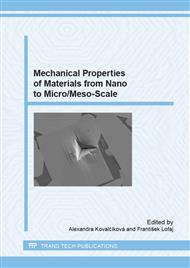p.197
p.201
p.205
p.209
p.213
p.217
p.221
p.225
p.229
Non-Destructive Analysis of Surfaces after Hard Milling Based on Barkhausen Noise Technique
Abstract:
This paper deals with the non-destructive evaluation of surface made of hardened roll bearing steel after hard milling via Barkhausen noise technique. The paper discusses magnetic anisotropy linked with the structure transformations with regard to variable flank wear of cutting tool. Effective value of Barkhausen noise (BN) and Peak Position derived from the raw BN signal as well as BN envelopes are compared with metallographic observations and theoretical background about magnetic domains reconfiguration when the near surface undergoes severe plastic deformation at elevated temperatures.
Info:
Periodical:
Pages:
213-216
Citation:
Online since:
September 2015
Authors:
Keywords:
Price:
Сopyright:
© 2015 Trans Tech Publications Ltd. All Rights Reserved
Share:
Citation:


